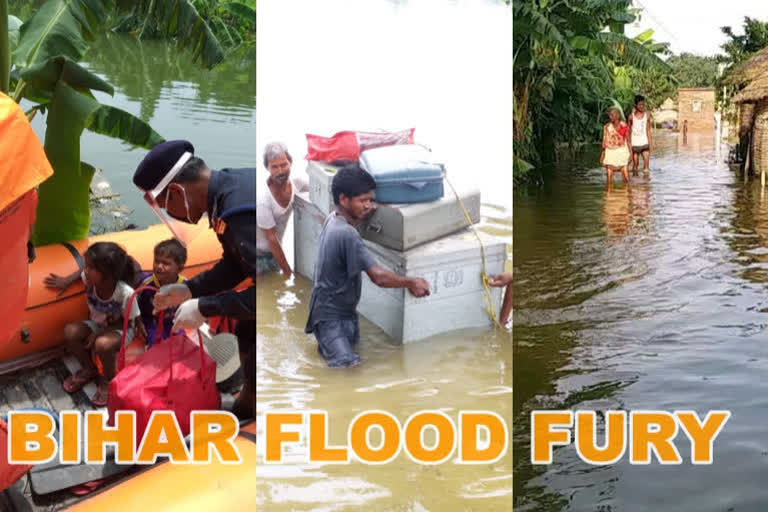Patna: Bihar has been facing floods every year over the past 40 years. According to the Water Resource Department of Bihar government, 68 thousand 800 square km area of the state are submerged in floods and 12 districts are hit every year. However, the year 2020 has created a new record as 20 districts of Bihar are hit by floods and four districts are partially affected. Floods have affected public life in 24 districts out of 38 in Bihar.
As and when there is a debate about Bihar’s perennial flood woes, hopes are raised but finally, everything is lost in the box of files scattered from Patna to Delhi, but do not give up the hope that one-day things will change and will take anti-flood schemes to their logical conclusion. What finally is done is nothing but a kind of formality when a bare minimum work with regard to repairing the embankment is carried out, but in reality, people are left to repent and curse themselves for being doomed to face the flood tragedy.
Flood control details
If we talk about details with regard to floods and measures to control them, Bihar had 25 lakh hectares of flood-affected area in 1954, while there was 160 km long embankment. In 2020, 73.01 lakh hectares of the area have been affected by floods, while the length of the embankment increased to 700 km. In fact, the way floods have spread their tentacles in Bihar, all efforts to control them have proved inadequate. It is not true that the river Kosi is the only reason for floods in Bihar. No doubt the river Kosi which flows in Bihar causes floods in the areas the river passes through, but there are other reasons as well, which cause deluge every year.
The total area Kosi river gets water from is estimated to be 74 thousand 030 square kilometres out of which 62 thousand 620 square kilometres are in Nepal and Tibet. Only 11 thousand 410 square kilometres are in Bihar. Needless to say, messing up with nature has also become a major cause of floods in the state. Indiscriminate felling of trees in the catchment area of forests is one such reason. The dam on Kosi River in Nepal is the main cause of floods in Bihar. The dam was built in 1956 following a treaty between Nepal and India. As per the treaty, if more water accumulates in the Kosi River in Nepal, then the Himalayan nation has the right to open the dam gates, which causes flood in Bihar.
Accumulation of silt is a major cause of deluge
The accumulation of silt in rivers is another big reason for flooding. In Bihar, the river Ganga gets a maximum amount of water from different other sources. At least, 35 tributary rivers flow into the Ganga. These rivers bring not only water but also a large quantity of silt along with them. These silts do not only disturb the flow and direction of the river but have also affected the natural process of water conservation. Many schemes were formulated to address this problem but in vain. Some efforts were made to remove the silt from the Ganga during the tenure of Prime Minister Atal Bihar Vajpayee and Union Shipping Minister Shatrughan Sinha. These efforts, however, could not be taken to their logical conclusion.
Kosi tragedy led to talks but no solution
After the devastating Kosi floods, there were myriad kinds of talks and discussions about various projects to address the menacing floods in Bihar, but none of these projects could take a concrete shape. In 2016, Chief Minister Nitish Kumar held a marathon meeting with experts to find a lasting solution to floods caused by rivers. Aerial survey was also conducted to understand and discuss the problem in totality, but everything was wrapped up in official files and nothing concrete happened.
Needless to say, there is no dearth of talks about Bihar’s flood problem and its possible solution, but everything is lost to politics when the time comes to take discussions forward. It has been discussed many times to take water from north Bihar to south Bihar so that the problem of floods is addressed in one part of the state and that of drought in another part of Bihar. It sounds so lofty but the rigmarole of red-tapism becomes a major stumbling block in transforming ideas into action. All projects which were mooted to link all rivers in the state were aborted before they could kickstart.
Burhi Gandak-Noon-Baya-Ganga link
A detailed project report (DPR) was submitted on January 8, 2014, according to which a 71 km long canal was proposed to be constructed through which the water of Burhi Gandak River was to be flown into the Ganga through Noon and Baya rivers. This project was intended to save Vaishali, Samastipur and Muzaffarpur districts from annual floods. It was also said that once completed, this project would help in developing the irrigation capacity of 2 lakh 47 thousand and 001 hectares of land. The estimated cost of the project in 2014 was Rs 4213.8 crore, which is now said to have gone up to Rs 6,500 crore.
Kosi-Mechi link
The DPR for Kosi-Mechi link was submitted on May 2, 2014, under which a 120.15 km long canal is to be constructed. The water of Kosi basin will be brought from Mechi link to Mahananda basin, due to which more than 2 lakh 14 thousand hectare fields will get irrigation facility. It is expected to benefit Supaul, Saharsa, Araria, Kishanganj and Purnia districts. Its estimated cost was pegged at about Rs 5,000 crore, which is now estimated to increase to Rs 7,500 crore.
